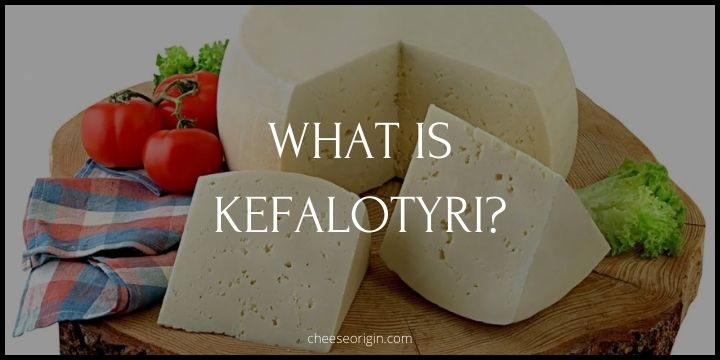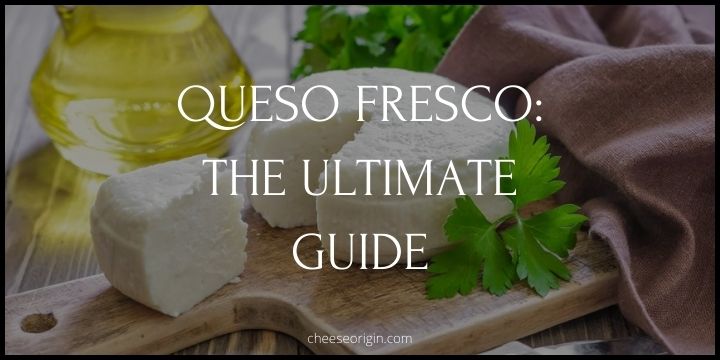What is Robiola? A Taste of Piedmont, Italy

Welcome to a gastronomic journey that will transport us to the verdant valleys of Piedmont, Italy. In this region, nestled among vineyards producing some of the world’s most acclaimed wines, lies a culinary secret that has been passed down through generations – Robiola cheese.
This isn’t just any cheese, but a testament to the art of Italian cheesemaking, a delicate delight that captures the essence of its terroir in every bite.
Join us as we delve into the world of Robiola, exploring its unique characteristics, rich history, and the role it plays in the culinary tapestry of Piedmont.
Quick Facts About Robiola
| Quick Facts | Description |
|---|---|
| Origin | Piedmont region, Italy |
| Type | Soft-ripened cheese |
| Milk Source | Traditionally a mix of cow, goat and sheep’s milk, but can also be made from one type alone |
| Ageing Process | Usually aged for 3 to 4 weeks, but can vary |
| Texture | Creamy, smooth, and slightly grainy |
| Taste | Mild and milky with hints of nuts and fruit |
| Rind | Edible, thin, and bloomy |
| Pairings | Pairs well with light white wines, fresh fruits, honey, and crusty bread |
| Uses | Suitable for spreading on bread or crackers, in salads, or melted in pasta dishes |
| Varieties | Robiola Bosina, Robiola Di Roccaverano, Robiola Rocchetta, among others |
| Storage | Keep in the fridge, ideally in a cheese drawer or wrapped in wax paper |
| Nutritional Values | High in protein, calcium, and beneficial bacteria, while being relatively low in calories compared to other cheeses |
| DOP Status | Several varieties of Robiola have been granted Protected Designation of Origin (DOP) status by the European Union |
What is Robiola?
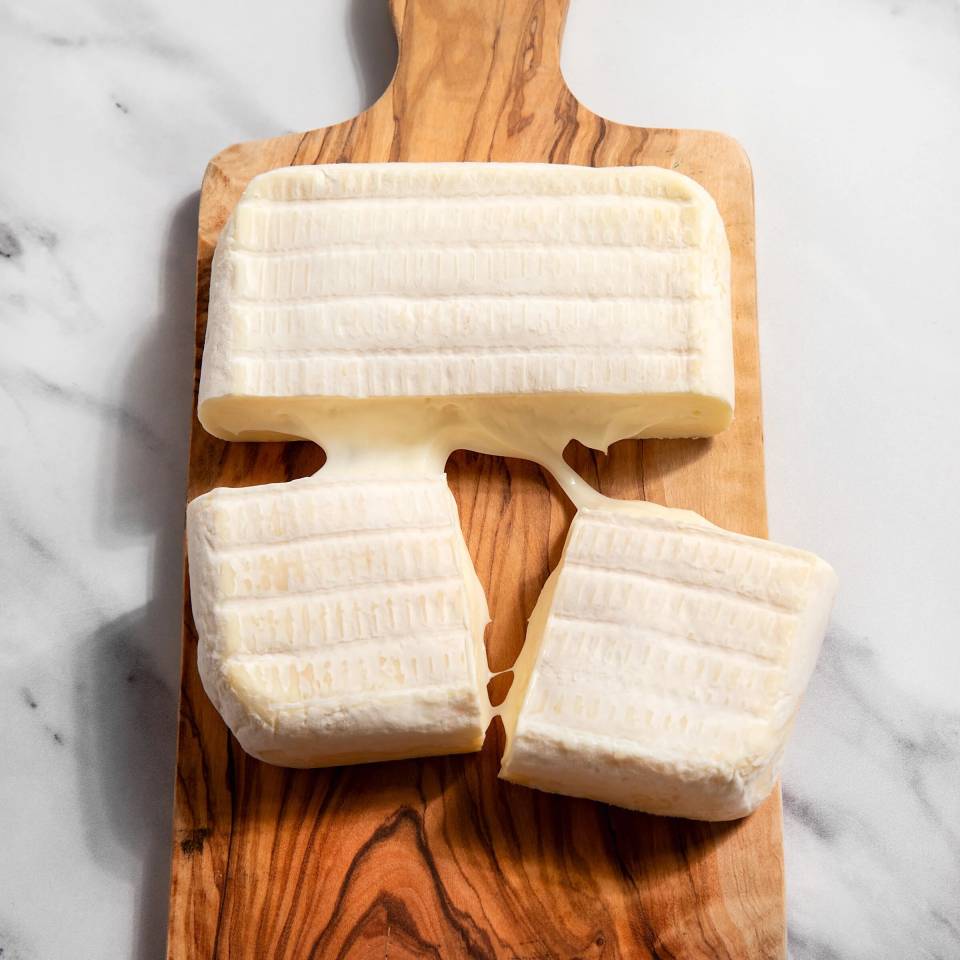
Robiola is a fascinating and delectable cheese originating from the Piedmont region of Italy. Known for its creamy texture and mild, milky flavor, it’s a beloved part of Italian cuisine and has made its mark in the international cheese scene.
What sets Robiola apart is its unique blend of milk. Traditionally, it’s made from a combination of cow, goat, and sheep’s milk. However, some varieties are made from just one type of milk, resulting in a range of flavors and textures across different Robiola cheeses. The aging process typically lasts around three to four weeks, but this can vary, further diversifying the Robiola family.
The taste of Robiola is mild with a hint of fruitiness and nuttiness. Its texture is smooth, slightly grainy, and very spreadable, making it a perfect companion for crusty bread or crackers. It’s also often used in salads or melted into pasta dishes, adding a creamy touch to these meals.
Besides its delightful flavor and texture, Robiola boasts an edible, thin, bloomy rind that adds a layer of complexity to its profile. When it comes to pairing, this cheese goes well with light white wines and fresh fruits, offering a balance of sweet and savory elements.
Moreover, several varieties of Robiola have been recognized with Protected Designation of Origin (DOP) status by the European Union, highlighting their quality and connection to the regions where they’re produced. Among these are Robiola Bosina, Robiola Di Roccaverano, and Robiola Rocchetta.
Nutritionally, Robiola is a great source of protein, calcium, and beneficial bacteria. Despite its rich, indulgent nature, it’s relatively low in calories compared to other cheeses, making it a healthier choice for cheese lovers.
What Does Robiola Taste Like?
Robiola cheese offers a unique and pleasant flavor profile that’s both complex and satisfying.
At its core, Robiola has a mild and milky taste, reflective of its primary ingredient – milk. The blend of cow, sheep, and goat’s milk creates a harmonious symphony of flavors that’s truly distinctive. The goat’s milk imparts a slight tanginess, the sheep’s milk adds a hint of sweetness, and the cow’s milk rounds it out with a creamy and buttery undertone.
Additionally, Robiola often carries subtle hints of nuts and fruits, offering an intriguing complexity to its otherwise gentle flavor. As the cheese ages, these nuances can become more pronounced, leading to a deeper and richer taste.
The rind of the Robiola is edible and thin, and it contributes to the overall taste with a slight earthy note. This complements the creamy and luscious interior perfectly, making each bite a delightful experience.
The texture of Robiola is smooth and slightly grainy, which adds to its mouthfeel and enhances the tasting experience. When paired with light white wines, fresh fruits, or honey, the delicate flavors of Robiola get a chance to shine, making it a versatile choice for various culinary explorations.
Robiola Tasting Notes
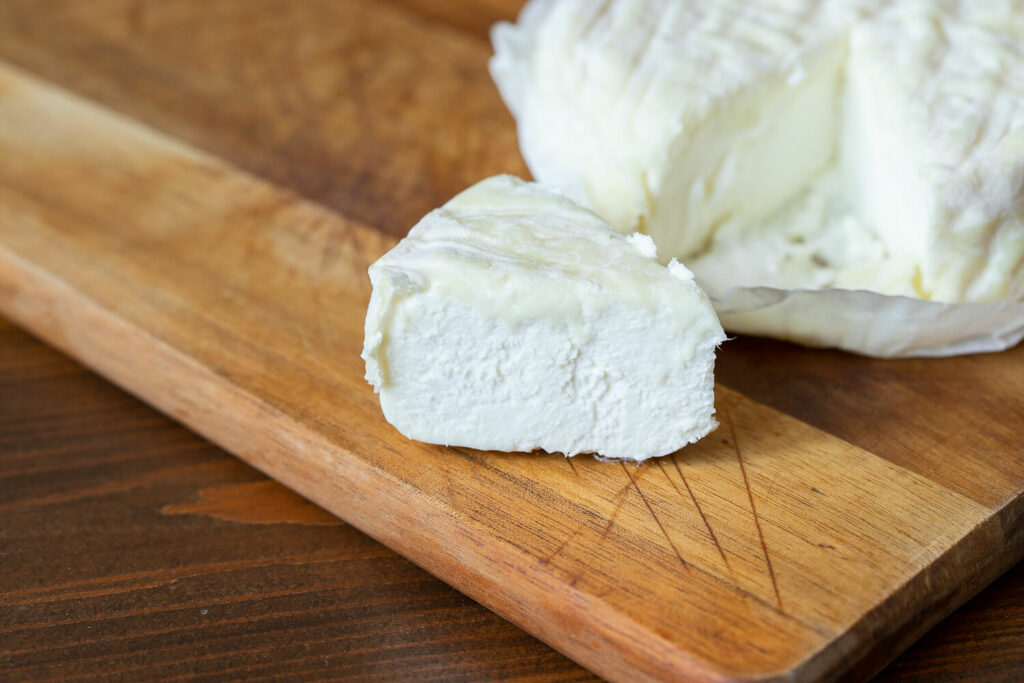
- Texture: Robiola has a creamy and slightly grainy texture. It’s soft and spreadable, making it perfect for spreading on bread or crackers.
- Color: The cheese itself is typically white to straw-yellow, while the thin rind ranges from white to light brown depending on the age of the cheese.
- Smell: The aroma of Robiola can be described as fresh and milky, with a slight hint of earthiness from the rind.
- Taste: Robiola offers a mild and milky flavor. Thanks to the blend of cow, sheep, and goat’s milk, there’s a harmonious interplay of subtle tanginess, sweetness, and creaminess.
- Aftertaste: The aftertaste often reveals subtle notes of nuts and fruits, adding complexity to its flavor profile. As the cheese ages, these nuances can become more pronounced.
- Rind Flavor: The edible rind of Robiola contributes an earthy note to the overall taste, complementing the creamy interior.
- Pairings: Robiola pairs wonderfully with light white wines, enhancing their fruity notes. It also goes well with fresh fruits like pears and figs, or drizzled with honey. Its creamy nature makes it a good match for crusty bread and crackers too.
- Aging Influence: The aging process influences Robiola’s taste significantly. Younger Robiola is milder and creamier, while more aged Robiola develops a deeper, richer flavor with more pronounced fruity and nutty notes.
- Variety Differences: Different varieties of Robiola can have slightly different tasting notes. For example, Robiola Bosina has a richer, fuller flavor due to the use of both cow’s and sheep’s milk, while Robiola Di Roccaverano, made only with goat’s milk, has a more tangy note.
The 6 Different Types of Robiola
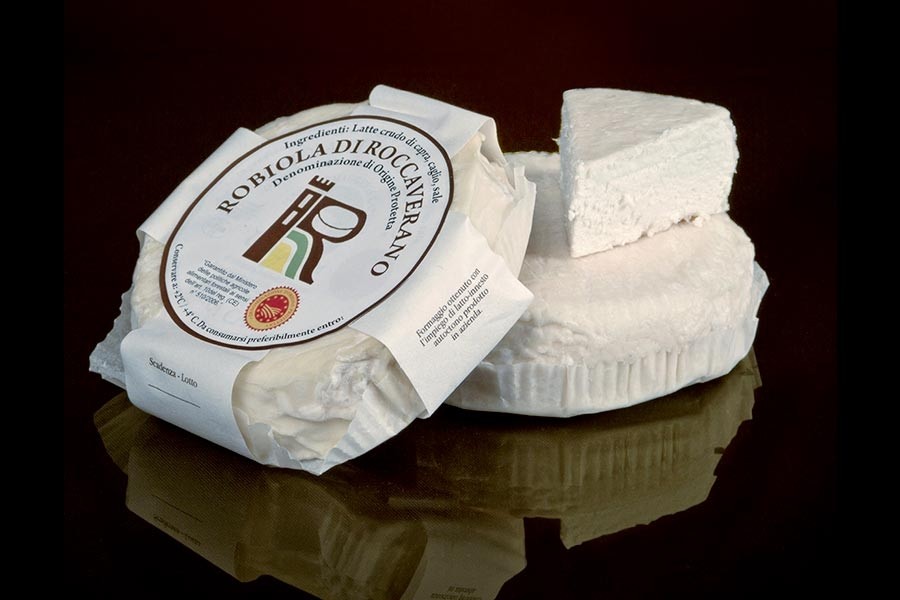
| Type of Robiola | Description | Milk Type | Aging Period | Protected Designation of Origin (DOP) |
|---|---|---|---|---|
| Robiola Bosina | Known for its rich and full flavor, it’s a blend of cow and sheep’s milk. It has a soft and creamy texture with a bloomy rind. | Cow and Sheep | 2-3 weeks | Yes |
| Robiola di Roccaverano | Made solely from goat’s milk, it has a more pronounced tangy note. Its texture is soft and creamy, and it has a thin, edible rind. | Goat | Minimum 15 days | Yes |
| Robiola Rocchetta | This variety combines the milk of three animals – cow, goat, and sheep. It has a mild yet complex flavor profile and a soft, creamy texture. | Cow, Goat, and Sheep | 3-4 weeks | No |
| Robiola Piemonte | This version is made from cow’s milk. It has a fresh, milky flavor with a slight tanginess and a smooth, creamy texture. | Cow | 1-2 weeks | No |
| Robiola delle Langhe | Made from cow and sheep milk, it has a delicate, creamy taste with a hint of sweetness and a soft texture. | Cow and Sheep | 2-3 weeks | No |
| Robiola Incavolata | This type is wrapped in cabbage leaves, which imparts a distinct, earthy flavor to the cheese. It’s typically made from cow’s milk. | Cow | Varies | No |
What Are The Uses of Robiola?
Robiola cheese is versatile and can be used in various culinary applications.
- Spread: Due to its creamy texture, Robiola is perfect for spreading on crusty bread, toast, or crackers.
- Cheese Platter: Robiola makes a great addition to any cheese platter due to its mild yet complex flavor. It pairs well with fresh fruits like grapes, figs, or pears, and nuts like almonds or walnuts.
- Cooking: Robiola can be used in cooking, especially in recipes that call for soft, creamy cheeses. It can be used in pasta sauces, risotto, or melted over vegetables.
- Baking: You can bake Robiola in a puff pastry with some honey or jam for a delicious appetizer or dessert.
- Salads: Robiola can be crumbled or sliced into salads to add a creamy texture and rich flavor.
- Sandwiches and Wraps: Use Robiola as a spread in sandwiches and wraps for a gourmet touch.
- Desserts: The cheese can also be used in desserts. Its creamy texture and mild flavor work well in cheesecakes and other sweet treats.
- Pairing with Wine: Robiola pairs beautifully with light white wines or sparkling wines, making it an excellent choice for wine and cheese tastings.
Note: Robiola is best served at room temperature to fully enjoy its flavor and texture.
Is Robiola Healthy?
Robiola is a type of cheese that, like most dairy products, contains a good amount of proteins and fats. A 50g serving of Robiola provides around 168 calories. It’s also a good source of protein, providing about 13% of daily value per 100g.
However, Robiola does not contain any fiber. It also has a considerable amount of fat and sodium. For instance, one source indicates that Robiola cheese contains about 39.3g of fat and 1190mg of sodium.
Despite its high-fat content, full-fat cheese like Robiola can be part of a healthy diet when eaten in moderation. In fact, full-fat cheese can be a healthy snack and a great way to make a bland meal taste better.
Moreover, certain varieties of Robiola may contain probiotic bacteria, which can benefit the health of consumers.
10 Best Robiola Substitutes
| Substitute | Description |
|---|---|
| Brie | Brie is a soft, creamy cheese that has a similar texture and mild flavor to Robiola. It can be used in most recipes that call for Robiola. |
| Camembert | Camembert is another soft, creamy cheese that can be used as a substitute for Robiola. It has a stronger, more robust flavor but melts well like Robiola. |
| Mascarpone | Mascarpone is an Italian cream cheese that can be used as a substitute for Robiola in recipes where the cheese needs to be spreadable. |
| Ricotta | Ricotta is a creamy, mild-flavored cheese that can be used as a replacement for Robiola in recipes that require a softer consistency. |
| Goat Cheese | Goat cheese has a tangy flavor that can replace the unique taste of Robiola. It can be used in salads, spreads, and other dishes that call for Robiola. |
| Cream Cheese | Cream cheese is an excellent substitute for Robiola in recipes that require a smooth, creamy texture. It’s easily available and affordable. |
| Neufchâtel | Neufchâtel is a French cheese that has a similar texture to Robiola. It can be used in a variety of recipes requiring a soft, spreadable cheese. |
| Taleggio | Taleggio is an Italian cheese with a strong aroma but a mild flavor. It can be used as a substitute for Robiola in many recipes. |
| Stracchino | Stracchino is another Italian cheese that can be used as a substitute for Robiola. It has a similar texture and mild flavor. |
| Feta | Feta is a Greek cheese that can be used as a substitute for Robiola in salads and other dishes. It has a strong flavor and crumbly texture. |
What Pairs Well With Robiola?

Food that goes well with Robiola:
| Category | Foods |
|---|---|
| Breads/Crackers | Baguettes, Ciabatta, Whole Grain Bread, Crackers |
| Fruits/Vegetables | Grapes, Pears, Apples, Figs, Olives, Roasted Vegetables, Cherry Tomatoes |
| Meats/Proteins | Prosciutto, Salami, Roasted Chicken, Smoked Salmon |
| Nuts/Seeds | Almonds, Walnuts, Pine Nuts |
| Condiments/Spreads | Honey, Fig Jam, Olive Oil, Truffle Oil |
| Other Cheeses | Gorgonzola, Mozzarella, Parmesan |
| Desserts | Chocolate, Cheesecake, Fruit Tarts |
Also read: 11 Best Crackers that Pair Well with Cheese
Beverage that goes well with Robiola:
| Category | Beverages |
|---|---|
| White Wine | Chardonnay, Sauvignon Blanc, Pinot Grigio |
| Red Wine | Merlot, Pinot Noir, Cabernet Sauvignon |
| Sparkling Wine | Prosecco, Champagne |
| Beer | Light Ales, Wheat Beers, Pilsners |
| Non-Alcoholic | Sparkling Water, Apple Cider, Grape Juice |
Also read: Best Wine and Cheese Pairings: The Ultimate Guide
The History and Origin of Robiola
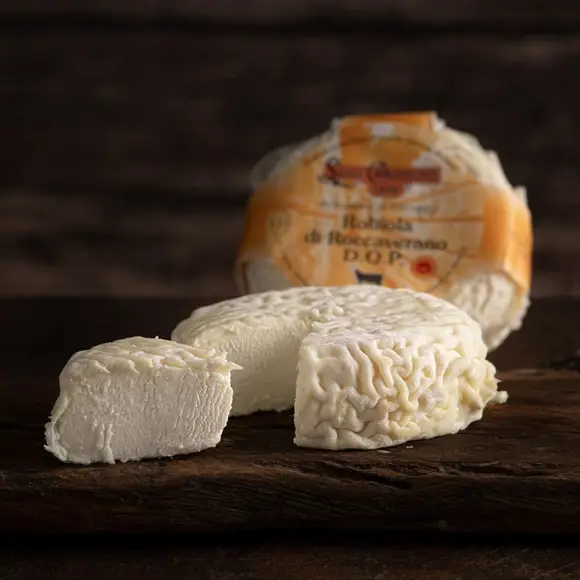
Robiola cheese has a rich and fascinating history that dates back to ancient times. Originating in Italy, particularly in the Piedmont region, the first documented reference of Robiola cheese dates back to 1000 AD, although its roots are believed to be even older. Historical accounts suggest that the cheese was first made by the Celto-Ligurian farmers of the Alta Langa, an area within the province of Cuneo, in Piedmont. These early farmers were known for their pastoral lifestyle and cheese-making skills.
Interestingly, the cheese’s origin as a goat cheese is thought to be Celtic. The Celts, who settled in today’s Liguria, started producing a cheese that would later evolve into the Robiola we know today. This makes Robiola one of the oldest cheeses still in production.
The traditional production methods of Robiola cheese involve using milk from either one or a combination of cows, goats, and sheep. The milk is gently heated and mixed with natural rennet to start the coagulation process. The curd is then cut, drained, and molded. The cheese is usually aged for a few weeks, which allows it to develop its characteristic flavor and creamy texture.
There are numerous varieties of Robiola cheese, each with their unique characteristics, largely influenced by the type of milk used and the duration of aging. One notable variety is Robiola di Roccaverano, a special breed and the only Italian historical goat milk cheese still in production according to procedures established some 200 years ago. It has a delicate, sweet flavor with a hint of acidity.
Robiola cheese is renowned for its soft and creamy texture with a velvety rind. It has a mild yet complex flavor profile, which can range from tangy and rich to buttery and milky, depending on the age of the cheese. Its versatility makes it a favorite in many recipes, from simple spreads to gourmet dishes.
The cultural significance of Robiola cheese is immense. It’s not just a part of the culinary tradition of Italy, but it also represents the historical and agricultural heritage of the region. The cheese was even mentioned in the writings of Pliny the Elder, a famous naturalist and philosopher of ancient Rome, which attests to its historical relevance.
Artisanal producers of Robiola cheese worldwide continue to uphold the traditional methods of production, ensuring the cheese’s quality and authenticity. These producers are often small-scale farmers who take great pride in their craft, contributing to the preservation and promotion of this historical cheese.
In conclusion, Robiola cheese is more than just a culinary delight; it’s a testament to ancient traditions, regional heritage, and artisanal craftsmanship. Its enduring popularity is a testament to its unique characteristics and the skill of the cheese-makers who have passed down their knowledge and passion through generations.

Frequently Asked Questions
1. Is Robiola cream cheese?
No, Robiola is not cream cheese. While they both have a creamy texture, they are different types of cheese. Robiola is an Italian soft-ripened cheese that can be made from varying proportions of cow’s, goat’s, or sheep’s milk.
It has a soft, creamy consistency and an intense, pleasant taste. Some people describe its texture as similar to cream cheese, but it has a unique flavor profile that sets it apart. So while Robiola can be used in some of the same ways as cream cheese, they are not the same thing.
| Feature | Robiola | Cream Cheese |
|---|---|---|
| Origin | Italy, specifically the Piedmont region | United States |
| Milk Source | Cow’s, goat’s, or sheep’s milk | Cow’s milk |
| Texture | Soft, creamy, sometimes with a bloomy rind | Soft, smooth, spreadable |
| Flavor | Mild yet complex, can be tangy or buttery depending on the age | Mild, slightly sweet, and tangy |
| Aging Process | Usually aged for a few weeks | Not aged |
| Fat Content | Varies, generally high | High |
| Uses | Can be used in cooking, spread on bread, in salads | Commonly used as a spread, in baking, and in desserts |
2. How long does Robiola last?
Robiola cheese, if properly stored in the refrigerator, typically lasts for about 2 to 3 weeks once opened. However, it’s always best to check for signs of spoilage such as mold or an off smell before consuming.
3. Can I eat the rind of Robiola?
Robiola cheese, if properly stored in the refrigerator, typically lasts for about 2 to 3 weeks once opened. However, it’s always best to check for signs of spoilage such as mold or an off smell before consuming.
Also read:
- Queso Fresco: A Delightful Journey through its Complex Flavors
- All About Roquefort: An Insider’s Guide to the King of Blue Cheese
- Asiago Cheese: An In-depth Exploration of Nutrition and Taste
- Queso de Bola: The Classic Cheese of Celebrations
- What is American Cheese? The Controversial Delight of the Dairy World
- Emmental: A Comprehensive Guide to Switzerland’s Cheese Haven
- The Ultimate Guide to Kasseri: A Taste of Tradition




